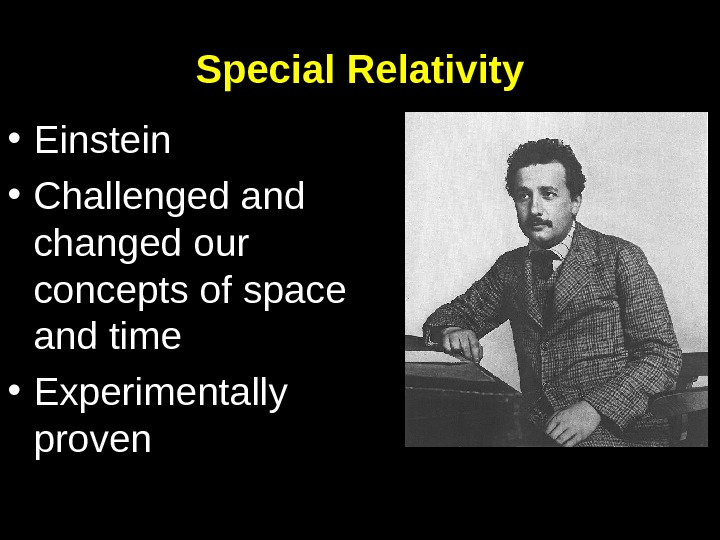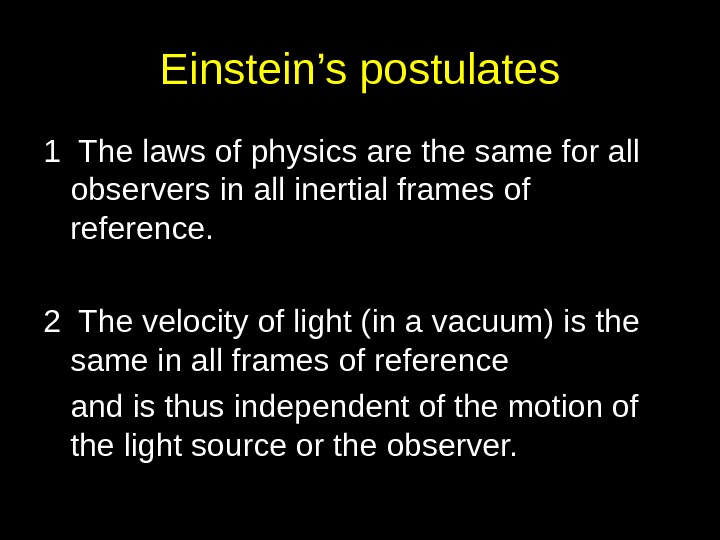LECTURE 23 & 24 : Special Relativity















- Размер: 668.5 Кб
- Количество слайдов: 15
Описание презентации LECTURE 23 & 24 : Special Relativity по слайдам
 LECTURE 23 & 24 : Special Relativity At the end of these lectures you should: • Understand “ frame of reference” and “ inertial frame of reference”. • Know that the velocity of light is invariant. • State Einstein’s postulates on which Special Relativity is based. • Understand “ time dilation” and be able to perform simple calculations. • Understand “ length contraction” and be able to perform simple calculations. • Understand Einstein’s equation E = mc 2 and be able to perform calculations using this equation. • Understand use relativistic equations for total energy and kinetic energy.
LECTURE 23 & 24 : Special Relativity At the end of these lectures you should: • Understand “ frame of reference” and “ inertial frame of reference”. • Know that the velocity of light is invariant. • State Einstein’s postulates on which Special Relativity is based. • Understand “ time dilation” and be able to perform simple calculations. • Understand “ length contraction” and be able to perform simple calculations. • Understand Einstein’s equation E = mc 2 and be able to perform calculations using this equation. • Understand use relativistic equations for total energy and kinetic energy.
 Special Relativity • Einstein • Challenged and changed our concepts of space and time • Experimentally proven
Special Relativity • Einstein • Challenged and changed our concepts of space and time • Experimentally proven
 Frame of reference A place with respect to which measurements are made eg Inertial frame of reference One in which Newton’s Laws hold How would you know if you were in a frame of reference which is accelerating with respect to an inertial frame?
Frame of reference A place with respect to which measurements are made eg Inertial frame of reference One in which Newton’s Laws hold How would you know if you were in a frame of reference which is accelerating with respect to an inertial frame?
 Classical Relativity Consider someone on a train throwing a ball : a) horizontally b) vertically upwards as measured by an observer in the train and an observer at the station
Classical Relativity Consider someone on a train throwing a ball : a) horizontally b) vertically upwards as measured by an observer in the train and an observer at the station
 What the observer on the train sees: He/she sees the ball moving horizontally at v bt (the speed relative to the train). What the observer at the station sees: He/she sees the ball moving horizontally at v bs = v bt + v ts where v ts is the speed of train relative to station. Ball thrown horizontally
What the observer on the train sees: He/she sees the ball moving horizontally at v bt (the speed relative to the train). What the observer at the station sees: He/she sees the ball moving horizontally at v bs = v bt + v ts where v ts is the speed of train relative to station. Ball thrown horizontally
 What the observer on the train sees: He/she sees the ball moving vertically up and down What the observer at the station sees: He/she sees the ball moving in a parabola. The horizontal speed is v ts . The vertical motion is just motion under gravity. Ball thrown vertically
What the observer on the train sees: He/she sees the ball moving vertically up and down What the observer at the station sees: He/she sees the ball moving in a parabola. The horizontal speed is v ts . The vertical motion is just motion under gravity. Ball thrown vertically
 What are Einstein’s postulates?
What are Einstein’s postulates?
 Einstein’s postulates 1 The laws of physics are the same for all observers in all inertial frames of reference. 2 The velocity of light (in a vacuum) is the same in all frames of reference and is thus independent of the motion of the light source or the observer.
Einstein’s postulates 1 The laws of physics are the same for all observers in all inertial frames of reference. 2 The velocity of light (in a vacuum) is the same in all frames of reference and is thus independent of the motion of the light source or the observer.
 Event 1: light sets out Event 2: light returns to its starting point Zoe in the spaceship measures time between 2 events in the spaceship Adam on the Earth measures time between same 2 events
Event 1: light sets out Event 2: light returns to its starting point Zoe in the spaceship measures time between 2 events in the spaceship Adam on the Earth measures time between same 2 events
 c D TP 2 c L T 2 22 1 c v T TP Zoe: Proper Time (Events in same place) Adam: Measures time interval between events in different places. (Measures time intervals between events on a moving frame of reference). Time Dilation 2 22 2 4 D Tv L
c D TP 2 c L T 2 22 1 c v T TP Zoe: Proper Time (Events in same place) Adam: Measures time interval between events in different places. (Measures time intervals between events on a moving frame of reference). Time Dilation 2 22 2 4 D Tv L
 • Proper time This is when only one clock is required to measure the time interval between two events that occur at the same place in that frame of reference (Zoe’s frame) • Time measured by Adam is “slower” or “dilated” compared with time measured in a frame of reference (Zoe’s) which is moving with respect to Adam’s frame of reference.
• Proper time This is when only one clock is required to measure the time interval between two events that occur at the same place in that frame of reference (Zoe’s frame) • Time measured by Adam is “slower” or “dilated” compared with time measured in a frame of reference (Zoe’s) which is moving with respect to Adam’s frame of reference.
 Time dilation The time interval between two events is shortest in a frame of reference in which the events occur at the same place. Example 1 A spaceship completes a one-way journey that takes 25 years according to observers on Earth. If the spaceship travels at 0. 95 c relative to Earth, how long does an astronaut on board the spaceship consider the journey to take?
Time dilation The time interval between two events is shortest in a frame of reference in which the events occur at the same place. Example 1 A spaceship completes a one-way journey that takes 25 years according to observers on Earth. If the spaceship travels at 0. 95 c relative to Earth, how long does an astronaut on board the spaceship consider the journey to take?
 Example 2 A stationary muon decays in 2. 2 μ s. What is its lifetime as observed from a laboratory on Earth if the muon is moving at 0. 97 c relative to Earth? How far does it travel in this time? (This situation provides experimental evidence for time dilation).
Example 2 A stationary muon decays in 2. 2 μ s. What is its lifetime as observed from a laboratory on Earth if the muon is moving at 0. 97 c relative to Earth? How far does it travel in this time? (This situation provides experimental evidence for time dilation).
 LECTURE : CHECK LIST READING Adams and Allday: 8. 23, 3. 19, 8. 24, 8. 25 At the end of these lectures you should • Understand the concepts of frame of reference and inertial frame of reference. • Know that the velocity of light is invariant. • State Einstein’s postulates on which Special Relativity is based • Understand what is meant by time dilation and be able to perform simple calculations. • Understand what is meant by length contraction and be able to perform simple calculations. • Understand Einstein’s equation E = mc 2 and be able to perform calculations using this equation. • Understand use relativistic equations for total energy and kinetic energy.
LECTURE : CHECK LIST READING Adams and Allday: 8. 23, 3. 19, 8. 24, 8. 25 At the end of these lectures you should • Understand the concepts of frame of reference and inertial frame of reference. • Know that the velocity of light is invariant. • State Einstein’s postulates on which Special Relativity is based • Understand what is meant by time dilation and be able to perform simple calculations. • Understand what is meant by length contraction and be able to perform simple calculations. • Understand Einstein’s equation E = mc 2 and be able to perform calculations using this equation. • Understand use relativistic equations for total energy and kinetic energy.
 Additional Materials • Check out the websites at: • http: //www. phys. unsw. edu. au/einsteinlight/j w/module 4_time_dilation. htm • http: //www. youtube. com/watch? v=x. NB 7 KEg 9 si. M&feature=results_video& playnext=1&list=PLC 560 B 8892351 ACAF • http: //www. squidoo. com/relativity_explanat ion • http: //www. youtube. com/watch? v=ev 9 zrt__lec
Additional Materials • Check out the websites at: • http: //www. phys. unsw. edu. au/einsteinlight/j w/module 4_time_dilation. htm • http: //www. youtube. com/watch? v=x. NB 7 KEg 9 si. M&feature=results_video& playnext=1&list=PLC 560 B 8892351 ACAF • http: //www. squidoo. com/relativity_explanat ion • http: //www. youtube. com/watch? v=ev 9 zrt__lec
